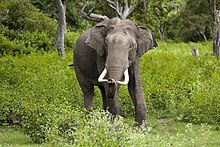
Back فيل هندي Arabic فيل هندى ARZ Fuzol (Elephas maximus indicus) AVK Hindistan fili Azerbaijani Индийски слон Bulgarian ভারতীয় হাতি Bengali/Bangla فیلی ھیندی CKB Elephas maximus indicus Czech Indisk elefant Danish Indischer Elefant German
| Indian elephant Temporal range: Pleistocene – Recent[1]
| |
|---|---|

| |
| A male elephant in Bandipur National Park | |

| |
| A female elephant in Nagerhole National Park | |
| Scientific classification | |
| Domain: | Eukaryota |
| Kingdom: | Animalia |
| Phylum: | Chordata |
| Class: | Mammalia |
| Order: | Proboscidea |
| Family: | Elephantidae |
| Genus: | Elephas |
| Species: | |
| Subspecies: | E. m. indicus
|
| Trinomial name | |
| Elephas maximus indicus Cuvier, 1798
| |
| Synonyms | |
|
E. m. bengalensis de Blainville, 1843 | |
The Indian elephant (Elephas maximus indicus) is one of three extant recognized subspecies of the Asian elephant, native to mainland Asia. The species is smaller than the African elephant species with a convex back and the highest body point on its head. The species exhibits significant sexual dimorphism with a male reaching an average shoulder height of about 3.2 m (10 ft) and weighing up to 5,400 kg (11,900 lb) whereas a female reaches an average shoulder height of about 2.54 m (8 ft 4 in) and weighs up to 4,160 kg (9,170 lb). It has a broader skull with a concave forehead, two large laterally folded ears and a large trunk. It has grey colored smooth skin with four large legs and a long tail.
The Indian elephant is native to mainland Asia with nearly three-fourth of the population found in India. The species is also found in other countries of the Indian subcontinent including Nepal, Bangladesh, Bhutan, Myanmar and South East Asian countries including Thailand, Malaysia, Laos, Cambodia, and Vietnam with small populations in China. It inhabits grasslands, dry deciduous, moist deciduous, evergreen and semi-evergreen forests across the range. The species is classified as a megaherbivore and consume up to 150 kg (330 lb) of plant matter per day. They consume a variety of diet depending on the habitat and seasons and might include leaves and twigs of fresh foliage, thorn bearing shoots, flowering plants, fruits and grass.
Since 1986, the Asian elephant has been listed as Endangered on the IUCN Red List as the wild population has declined by at least 50% over the last three elephant generations. The species is threatened by environmental degradation, habitat loss and fragmentation. Poaching of elephants for ivory is a serious threat in some parts of Asia. Project Elephant was launched in 1992 by the Government of India to protect elephant habitats and population.
The Indian elephant is a cultural symbol throughout its range and appears in various religious traditions and mythologies. The elephants are treated positively and is revered as a form of Lord Ganesha in Hinduism. It has been designated the national heritage animal in India and is the national animal of Thailand and Laos.
- ^ "fossilworks". Archived from the original on 12 December 2021. Retrieved 4 February 2022.
- ^ Cite error: The named reference
IUCNwas invoked but never defined (see the help page).
